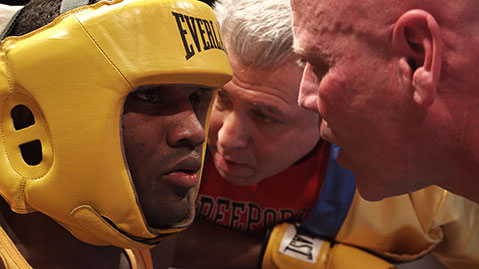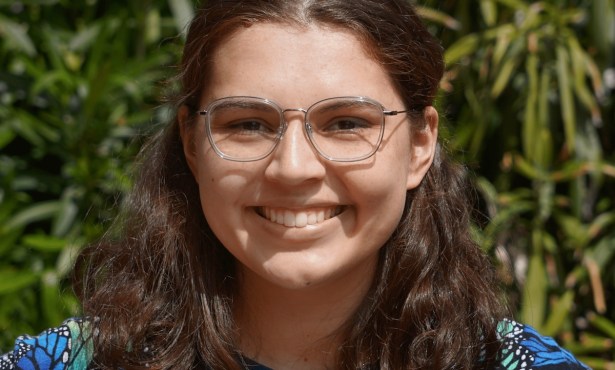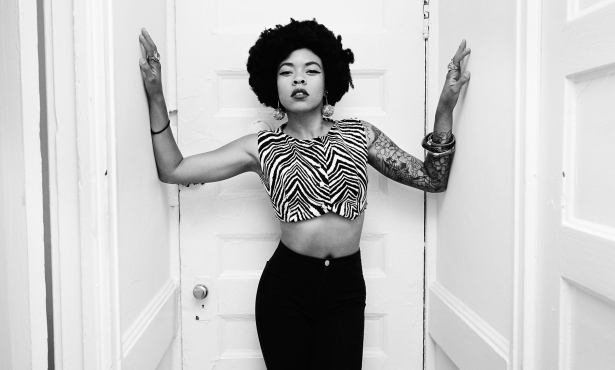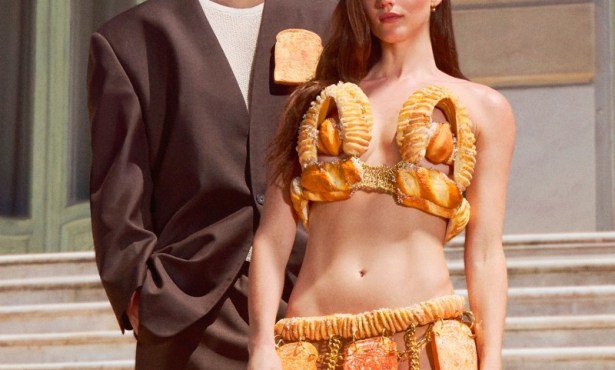Cradle of Champions
Director Bartle Bull

New York City’s Golden Gloves is the largest amateur boxing tournament on the planet, and the launching pad for some of the sport’s biggest names, from Muhammad Ali to Sugar Ray Robinson. This documentary takes a raw and intimate look at four participants, thereby showing New York’s many faces while relaying unique yet universal personal struggles on the path toward the championship.
Your background is as a Middle East reporter, so how did you discover this story?
In the years I spent reporting in Iraq, Syria, and elsewhere I always found that the local human stories were the best way for me to try to understand the bigger picture. All writing is at heart storytelling, and I found that frontline experience hugely helpful in filmmaking.
I discovered the Golden Gloves because some guys I boxed with in the last surviving gym in Harlem — now shut forever like so many others in New York — were in the tournament back in 2014 and I went to support them and discovered the most inspiring world. Most Gloves nights are in high school gyms, the basements of church halls, small neighborhood venues like that.
The first time I walked into one of these scenes, back in 2014, I was amazed — I had never seen all of the “tribes” of New York together in one place. And to see this in a totally positive atmosphere, nothing but respect, all celebrating the things at the heart of the American dream — hard work and courage — was utterly beautiful to me. The “haute doc” world is far too obsessed with parading its own virtue by insisting that this kind of thing can’t and doesn’t happen in our country.
Do you have any boxing experience yourself?
Harvard used to send a lot of fighters to the Golden Gloves when I was there 25 years ago, and that’s where I took it up, as an undergraduate. I’ve boxed in most places where I’ve settled down for more than a few weeks — Hong Kong, Syria, London, Azerbaijan — but whenever I get in good enough shape to start sparring, I always get roughed up so I’ve never had the guts to compete. I love the sport but I really don’t like hitting people in the face — I always apologize, which doesn’t usually help.
I like that the film really shows the two sides of New York: glitzy Manhattan and grittier places like the South Bronx, Freeport, and Staten Island.
When I started following the Daily News Golden Gloves in 2014, my friends who were in the tournament kept winning their initial fights, so I kept going back, night after night — it goes on for four nights a week for months.
So every evening I’d be planning my NYC adventure on Google Maps, and after a while I realized this was taking me all over the city, and into every nook and cranny of the five boroughs, and I was discovering more and more about the hometown that I’ve always loved. The film was partly conceived as a love letter to the city that gave me and my family so much and that represents — as anyone will see any night of the Gloves — the dreams of the world.
Did you just get lucky by covering the boxers you chose?
One of the first things I did once we’d secured access from the New York Daily News, which founded the tournament 90 years ago and still owns and supports it, was go to visit George Butler, maker of Pumping Iron, still the greatest sports film ever made and a true vérité classic.
Butler told me about trying to make a documentary about the world’s fastest horse, beginning with the Yearling sales in Kentucky. For nine years, every year they got the wrong horse, then they gave up. We didn’t want to be like Spellbound, essentially backfilling from halfway through. So we knew we would have to be really careful to cover our bases.
The remarkable thing was, from the very beginning of the tournament’s four-month odyssey, these four inspirational, fascinating figures just stood out from Day One, from the hundreds and hundreds of people around them. They just had the charisma and the stakes to drive a movie and you could see it even in a crowded room, these were people who moved through their world like angels: Titus, needing redemption before he moves on to manhood and a pro career; James, needing to grow up before he can change the circumstances of his family; Nisa, fighting for the respect of her son and that spark of brightness and glamor in a tough single mom’s life in the South Bronx; Coach Joe, probably dying from his 9/11 illnesses but kept alive by this beautiful sport.
Boxing is supposedly laden with behind-the-scenes politics, drama, and, to some extent, a criminal element. Did you run into any of that?
We never saw anything like that. The amateur game is pretty clean in general and there’s no money involved. We were the first outsiders given top-to-bottom, every day everywhere, access in the 90 years of the tournament and all we ever saw was an extraordinary world of honor and decency. I’ve watched hundreds of amateur bouts in New York City and seen only a handful of bad decisions.
Was it a challenge to shoot this world, including the fights?
Tom Hurwitz, our Director of Photography, assembled possibly the most awarded, talented team of shooters in vérité history. Kirsten Johnson’s Citizenfour won the Oscar while we were shooting. Matt Porwoll’s Cartel Land had recently won the Cinematography and Best Picture awards at Sundance. Tom himself is acknowledged as the dean of the entire practicing field. And so on. Our camera team loved the opportunity to shoot pure, real vérité.
And boxing of course is “made” for the movies. It happens to be one of the most cinematic pursuits there is. Getting Oscar-quality camera people into the corners between rounds gave us something the world has never seen before, real-life boxing drama up close, filmed by true cinematic greats at the absolute top of their profession. We frequently had three or five camera shoots on fight nights, so we were able to get unique coverage that’s never been done before in a documentary. At the Barclays Center finals we had seven camera crews, with sound, for two nights.
Boxing is very engrossing for a lot of artists, thinkers, and writers. It combines grace and beauty with a certain savagery — it’s pointless to pretend otherwise — and all the emotions of hope and fear, doubt, redemption, loneliness, and even love. It’s beautiful young people alone, near-naked, under the lights, testing themselves in front of the world, and it moves with a certain balletic quality, so for top shooters this is all a dream come true. They were able to master the physical side of it pretty swiftly and focus on capturing the poetry.
Were the boxers and other characters pretty open to talking about themselves or was that difficult?
Documentary cinematographers spend their lives being parachuted into intense experiences with disparate groups of people. Over thirty or forty years of a career, a documentary DP will have seen, with more intensity, more professions and lifestyles than just about anyone else. Meanwhile the cinematographer is always behaving in a way that might bring out the worst in people: getting in their way, asking them for favors, catching their weaknesses. So DP’s see a unique amount of “anthropology.”
This is certainly the case with the greatest of them all in this profession, our DP, Tom Hurwitz. Tom told me repeatedly over our very long and intense shoot that in decades of this work, he had never, ever, experienced a more respectful, helpful, polite community than the amateur boxing world of New York City.
It took us time to earn people’s trust. This is something that frontline journalists or top vérité cinematographers need to have a gift for. No outsiders had ever been allowed inside the tournament in its 90 year history. The community of competitive amateur boxing in any town or city will always be fairly private and guarded.
As the four-month saga wore on, I could sense a deepening comfort with us. From our leading characters to the tournament staff to literally everyone else in this very closed ecosystem, we were treated with the most extraordinary hospitality, respect, patience. Most of all we were trusted.
Part of it was that people were seeing — they would say this to me quite often — how professional the whole camera and sound team was. People got a sense fairly soon that these outsiders were hard-working, elite individuals, and that always generates respect. We were a complete pain in the neck for a lot of people, but all we got was this ever-deepening trust and patience. This just inspired us more to work even harder to give back to this world we came to love and get this story out there.
What do you hope for from the film’s future?
One of the huge privileges on this project has been the opportunity to work with the editor Michael Levine. He’s the most in-demand guy in vérité editing — which like vérité shooting is the highest form of its art. In Michael’s hands, with tons of time to perfect it, this amazing photography from a huge film crew has turned into a polished gem.
So we see the film as a work of art. But it’s also got an important message — this sport does more than any other activity to get our most at-risk inner city kids off the street, out of gangs, and into a world where they discover self-discipline, father figures, a work ethic, belief in their own courage. And another message beyond that: the American Dream values of aspiration, hope, risk-taking, courage all live on, even deep in our cities.
For the work of art, and for the message, our hope for the film is that it reaches the widest possible audience. Like all the great sports movies that we’d like to be compared to one day, Cradle of Champions isn’t really about sports at all. Fortunately the film is a true movie. It’s fun to watch: it’s beautiful to look at and it’s powerful emotionally but it’s also fun, it’s exciting, you end the movie on the edge of your seat with your heart pounding.
I think people are sick of the pompous side of the doc world, the sanctimonious, cliquey lecturing. Most of us pay our $15 in the theater — or our $2.99 on iTunes or our monthly Netflix fee — to have an intense experience based on storytelling, character, and art. With Cradle of Champions, we’re lucky to have this juicy, real-life drama shot and cut in a way that feels “Hollywood,” so our talks with big studios are going well.
What is your next project?
I’ve never had more fun or been more inspired than I was while making this film. I was ridiculously lucky, with a good budget, the world’s best creative talent, first-in-history access to a true American cultural treasure, and the most beautiful, inspiring characters I could ever hope to devote my time to. So I’d love to do another big vérité epic….but I also worry that I might not be able to handle it if it all doesn’t line up so perfectly next time.
I’d love to get access to the Trump White House. The world of professional bull riders must be full of drama, bravery, culture, tragedy — I bet that would be fascinating. I’d love to do a narrative feature film — the Battle of New York/Long Island/Brooklyn Heights in 1776 is a great story. I grew up reading old-fashioned books about heroes, so brave people inspire me.



